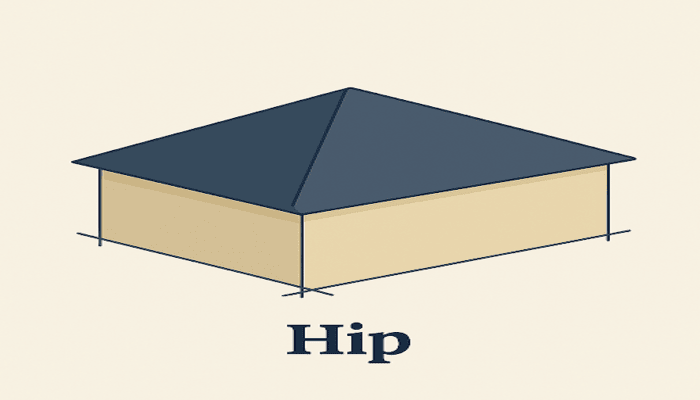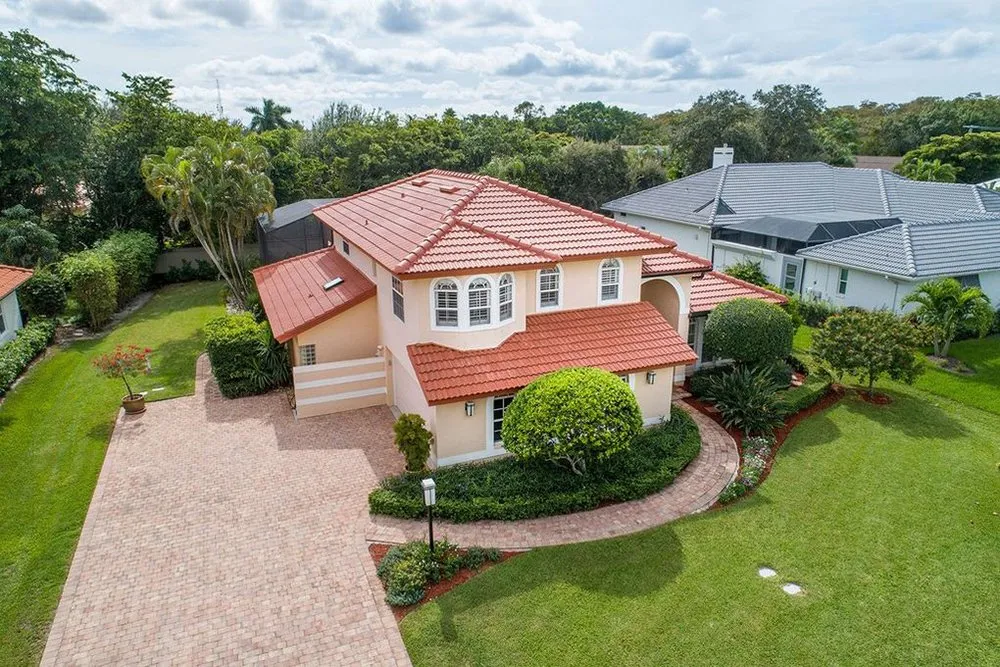What is a Hip Roof? Understanding One of the Most Durable Roofing Styles

When it comes to choosing a roofing style that offers strength, beauty, and weather resistance, few designs rival the hip roof. Recognized by its four sloping sides that meet at a ridge or point, the hip style roof has long been favored for its stability in high-wind areas, making it a perfect fit for homes in Southwest Florida. Its aerodynamic shape and even weight distribution make it less vulnerable to wind uplift, a major concern for homeowners facing Florida’s hurricane season.
Beyond durability, hip roofs also offer excellent rainwater management, helping to protect your home’s structure from moisture damage. Their clean, symmetrical appearance adds curb appeal while offering practical benefits that last for decades. If you’re planning a new roof installation or replacement, here’s everything you need to know about hip roofs, from their design advantages to material options and key construction considerations for Florida homeowners.
Defining the Hip Roof
A hip roof features four sides, each sloping downward toward the home’s walls. Unlike a gable roof, which has flat, vertical ends, the hip roof has no vertical surfaces — just clean, sloping lines. This gives it a low-profile, aerodynamic shape that naturally resists strong winds and heavy rain.
Depending on the home’s layout, the slopes can meet at a flat ridge or come together at a single point, creating variations like simple hips, pyramid hips, or more complex designs.
Key Characteristics of a Hip Roof
Here are the defining elements that set hip roofs apart:
- Sloping on All Sides: Every side slopes toward the walls at a gentle angle, creating a balanced, streamlined appearance. This uniformity not only adds to the visual appeal but also improves overall structural strength.
- No Gable Ends: Without vertical walls exposed to the elements, the design naturally minimizes wind resistance. This aerodynamic quality makes hip roofs especially reliable during strong storms and hurricanes.
- Eaves Around the Entire Home: Many hip roofs create shaded overhangs on all sides, protecting walls, windows, and doors from heavy rain and intense Florida sun. The added shade also helps lower cooling costs.
- Consistent Drainage: Water runs off in multiple directions, helping prevent leaks, pooling, and structural water damage. This consistent drainage is especially valuable in areas prone to heavy rainfall.
Thanks to their thoughtful design, hip roofs are widely considered one of the most durable and storm-ready styles for residential construction, offering long-term protection and aesthetic versatility.
Types of Hip Roof Designs
Depending on the architectural style of your home, you may encounter different versions of the hip roof:
1. Simple Hip Roof
This is the classic version: four equal-sized sides meeting at a ridge at the top. It’s common on traditional single-story homes and offers excellent drainage and wind resistance.
2. Pyramid Hip Roof
A pyramid hip roof has four identical triangular sides that meet at a single point, resembling a pyramid. This style is common for square buildings and outdoor structures like gazebos.
3. Cross Hip Roof
Cross hip roofs are used on more complex home layouts. They combine multiple hip sections, often meeting at valleys where two roof parts join. They add architectural interest and provide more dynamic curb appeal.
4. Dutch Hip Roof
A Dutch hip is a hybrid style that includes a small gable at the top of a hip roof. This design allows for additional attic space and ventilation while still offering the durability of a hip structure.
Each type has its advantages, but all are known for superior weather protection — a critical feature for homes in Naples and throughout Southwest Florida.
Why Choose a Hip Roof? Benefits for Florida Homeowners

A hip roof isn’t just about aesthetics — it delivers real functional advantages, particularly in storm-prone areas. Here’s why many homeowners opt for a hip-style roof:
1. Exceptional Wind Resistance
The sloping shape on all sides makes it harder for strong winds to lift or tear away roofing materials. In hurricane-prone regions like Southwest Florida, a hip roof can provide critical protection during the storm season.
2. Superior Rain Shedding
Because water runs off every side, hip roofs reduce the risk of leaks, pooling, or structural damage. This is especially important in Florida, where sudden heavy rains are common.
3. Increased Energy Efficiency
Hip roofs often support better attic ventilation, especially when paired with modern ventilation systems. This can help regulate indoor temperatures, reduce moisture buildup, and even lower cooling costs in the summer.
4. Consistent Shade and Sun Protection
The overhanging eaves on all sides offer natural shading, which helps protect exterior walls, doors, and windows. Over time, this can help preserve paint, prevent UV damage, and keep your home cooler.
5. Stylish, Balanced Appearance
The symmetrical look of a hip roof works beautifully with many home designs, from coastal cottages to upscale estates. It offers a timeless style that enhances both curb appeal and property value.
Materials Best Suited for Hip Roofs
Choosing the right material for your hip roof helps maximize its durability and aesthetic appeal. Here are some excellent options:
- Concrete Tiles: Perfect for homes with Mediterranean or Spanish architectural styles, these tiles are heavy but incredibly resilient. They can withstand harsh weather conditions but require extra structural support and a specialized installation process to handle the weight properly.
- Metal Roofing: Metal panels or standing seam roofs offer outstanding durability, energy efficiency, and hurricane resistance. They’re an especially smart choice for Florida homes battling heat and storms. Metal roofing also reflects sunlight, helping to reduce cooling costs during hot summer months.
- Asphalt Shingles: Affordable, lightweight, and available in many colors, asphalt shingles are one of the most popular roofing materials for hip roofs. They’re easy to install and provide reliable weather resistance, making them a budget-friendly option for homeowners looking for value without sacrificing performance.
Selecting the right roofing material depends on your design goals, budget, long-term durability expectations, and how much ongoing maintenance you’re willing to commit to. Working with an experienced roofing contractor can help you choose the best material to match both your aesthetic vision and functional needs.
Important Construction Considerations for Hip Roofs
When planning for a hip roof, a few construction details are essential for maximizing its performance in Florida’s climate:
- Roof Pitch: Moderate to steep pitches (around 30–45 degrees) offer the best rain runoff and storm performance.
- Underlayment: Install impact-rated, waterproof underlayment for added protection against leaks and wind-driven rain.
- Reinforced Trusses: Strong internal framing and hurricane ties help your roof withstand uplift forces during major storms.
- Proper Ventilation: Ridge vents, soffit vents, or attic fans ensure healthy airflow, preventing moisture problems and improving energy efficiency.
Working with an experienced roofing contractor like King Roofing Service Inc. ensures that your hip roof is built to handle Southwest Florida’s demanding conditions.
Is a Hip Roof Right for You?
Choosing a hip roof comes down to a few key questions:
- Do you live in a high-wind or hurricane-prone area?
- Are you looking for a low-maintenance roof with excellent drainage?
- Do you prefer a balanced, symmetrical aesthetic for your home?
- Are you planning to stay in your home long-term and want maximum durability?
If you answered “yes” to most of these, a hip style roof could be a smart, lasting investment. While hip roofs may cost a bit more upfront than simpler styles, they can save you money in insurance discounts, energy bills, and avoided storm repairs over the years. Over time, the added stability and protection they offer can help preserve your home’s structural integrity and reduce the frequency of costly maintenance. Plus, a well-built hip roof can boost your home’s resale value, making it an attractive feature for future buyers who value both beauty and strength.
Trust King Roofing Service Inc. for Expert Hip Roof
At King Roofing Service Inc., we have over 45 years of experience helping homeowners in Naples and Southwest Florida protect their homes with high-quality, expertly installed roofs. Our reputation is built on craftsmanship, reliability, and exceptional customer service.
Our team offers:
- Free roof inspections and estimates
- Tailored recommendations based on your needs and budget
- Fully licensed, insured, and hurricane-ready workmanship
- A 5-year transferable workmanship warranty for added peace of mind
We work closely with every client to ensure the right materials, designs, and reinforcements are chosen for lasting performance. If you’re considering a hip roof for your new build or replacement project, contact King Roofing Service Inc. today. We’ll walk you through every step of the process, answer all your questions, and ensure your home is protected for decades to come.












